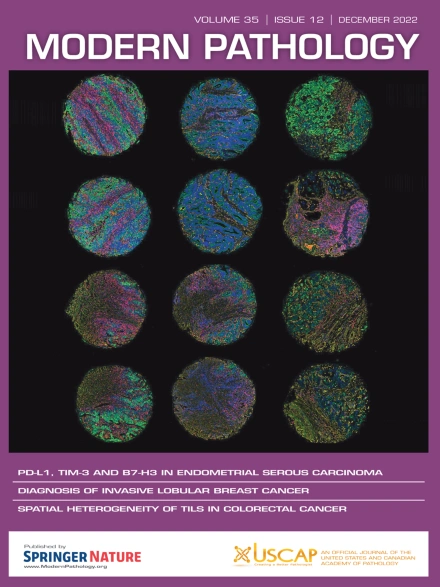TP53 Wild-Type, Human Papillomavirus-Independent Anal Growth/(Intra)Epithelial Lesion (ANGEL): A Potential Precursor of Anal Squamous Cell Carcinoma
IF 7.1
1区 医学
Q1 PATHOLOGY
引用次数: 0
Abstract
Human papillomavirus (HPV) underpins ∼90% of squamous cell carcinomas (SCCs) of the anus and perianal region. These tumors usually arise in association with precursor lesions such as anal intraepithelial neoplasia/high-grade squamous intraepithelial lesion, whereas a small subset of HPV-negative cancers may harbor mutations in TP53. Recently, vulvar lesions termed differentiated exophytic vulvar intraepithelial lesion/vulvar acanthosis with altered differentiated have been recognized as HPV-independent, TP53 wild-type precursors for vulvar carcinoma; however, analogous anal lesions have not been described. Cases of diagnostically challenging, TP53 wild-type HPV-negative anal squamous lesions with unusual histologic features including acanthosis and/or verrucous architecture were retrospectively identified. Lesions with koilocytic changes, lack of surface maturation, or significant cytologic atypia were excluded. HPV status was determined by immunohistochemistry for p16 and/or in situ hybridization for low- and high-risk strains, whereas TP53 status was assessed using immunohistochemistry and molecular studies in a subset of cases, with targeted molecular sequencing performed in 3 of these. All lesions (5/5) arose in men, ages ranging from 55 to 78 years (median: 65 years). Verrucous architecture was seen in 2 of 5 cases, 2 of 5 were predominantly acanthotic, and 1 of 5 had both verrucous and acanthotic growth. The lesions were characterized by hyperkeratosis (5/5), hypergranulosis (5/5), and cytoplasmic pallor of upper epithelial layers (2/5). All cases were negative for HPV and had wild-type p53 expression. Three cases with sufficient material for sequencing lacked alterations within the entire coding sequencing of TP53. Invasive SCC was concurrently present in 3 of 5 cases. In summary, verrucous and acanthotic HPV-independent TP53 wild-type squamous proliferation of the anal and perianal region, referred to herein as anal growth/(intra)epithelial lesion (ANGEL), are premalignant lesions that have the potential to become invasive, as most of our cases demonstrated synchronous SCC.
TP53 野生型、HPV 依赖性肛门生长/(内)上皮病变 (ANGEL):肛门鳞状细胞癌的潜在前兆。
本文章由计算机程序翻译,如有差异,请以英文原文为准。
求助全文
约1分钟内获得全文
求助全文
来源期刊

Modern Pathology
医学-病理学
CiteScore
14.30
自引率
2.70%
发文量
174
审稿时长
18 days
期刊介绍:
Modern Pathology, an international journal under the ownership of The United States & Canadian Academy of Pathology (USCAP), serves as an authoritative platform for publishing top-tier clinical and translational research studies in pathology.
Original manuscripts are the primary focus of Modern Pathology, complemented by impactful editorials, reviews, and practice guidelines covering all facets of precision diagnostics in human pathology. The journal's scope includes advancements in molecular diagnostics and genomic classifications of diseases, breakthroughs in immune-oncology, computational science, applied bioinformatics, and digital pathology.
 求助内容:
求助内容: 应助结果提醒方式:
应助结果提醒方式:


